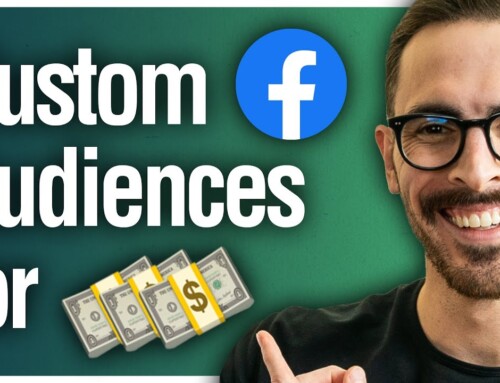TLDR; Thinkific reached out to 40 plus entrepreneurs and online course creators (including myself) to suss how to create a profitable online course. The article below, written by Tyler Basu, Content Marketing Manager for Thinkific, details those findings. If you’re looking to build and launch your online course (just like I did with Funnels101) I highly recommend you give this post a read.
How To Create A Profitable Online Course (7 Steps):

The demand for online courses is exploding right now (the global e-learning market reached an enormous $255 billion in 2017). It comes as no surprise that in response to this demand, thousands of companies and entrepreneurs have started creating online courses to sell to their audience and clients.
You might even already be one of these entrepreneurs. Perhaps you’ve been working directly with your clients as a freelancer, coach, consultant, or service provider. For you, creating online courses is a viable way to scale your business and increase your revenue without having to work with more clients on an 1-on-1 basis.
Or perhaps you’re starting a brand new business, and your online course(s) will be your primary source of revenue. In either case, the process for creating and launching a profitable online course remains the same. And yes, there is a proven process.
As the Content Marketing Manager for Thinkific, an online course platform used by more than 25,000 entrepreneurs and course creators (including our friend and client Paul Ramondo!), I’ve had the privilege of seeing what goes into creating and launching a successful online course. This may surprise you, but the process used by our most successful clients doesn’t actually begin with creating a course.
Interestingly, most entrepreneurs that jump straight into creating an online course before following the steps that come before it (which I’m about to share with you), typically end up creating a mediocre course, followed by a struggle to generate sales.
For an optimistic entrepreneur, spending valuable time and resources creating something that no one buys is a frustrating and discouraging experience. Fortunately, by following the 7 steps below, you’ll learn exactly how to create a profitable online course. These seven steps will save you from creating a course that no one is interested in buying and ensure the success of your course before you even create the first lesson.
Step 1: Choose a primary goal for your course
As exciting as it can be to start creating an online course, it’s important to take a step backward from the creation process and clarify why you’re creating a course in the first place. What objective will creating a course help you accomplish?
As we learned from the second habit in the late Stephen R. Covey’s classic book The 7 Habits of Highly Effective People: begin with the end in mind.
When it comes to creating online courses, this means knowing why you’re creating your course before you start creating it, and perhaps more importantly, defining what success looks like for you (not to be confused with the success of your students, which I’ll cover in a later step).
How will you know if your online course is successful?
To put it simply: you’ll know your course launch is successful if it achieves the objective you you established for it. This means identifying a specific goal for your course upfront and then measuring the success of your course by the extent to which it achieves that goal.
The vast majority of entrepreneurs that create online courses generally have one of three primary objectives for their courses:
Objective 1: To generate revenue for your business
The most common reason for creating online courses is to sell them at a profit. Thanks to a substantial and growing demand for online courses, coupled with low fulfilment costs of a digital product, selling online courses can be very lucrative.
Objective 2: To generate leads for your business
Instead of charging for your online course, you grant free access to your course in exchange for your prospect’s email address. You’re using a course to generate leads for your business, and generating revenue by promoting a related product or service to those people.
Objective 3: To help your existing clients achieve success
Instead of using a course to acquire a new client, you create a course to train your existing clients to better utilise some other product or service that they’ve already purchased from you. This approach has become increasingly popular among software companies (to teach their customers how to use their software), but online courses can also be used to supplement coaching, consulting, and done-for-you services.
The bottom line: Clarify the objective for your online course before you start creating it.
Step 2: Choose your course topic
Once you’ve clarified your primary objective for your online course, it’s time to decide what you’re going to teach.
As a starting point, I recommend making a list of potential topics for each of the following categories: your passions or interests, your skills, and your experience or achievements.

Take as much time as you need for this exercise, and don’t hold back. Try to identify as many potential topics as possible. Once you have these 3 lists completed, make a separate list of potential course topics that overlap all three categories.
For example, if you like photography (passion/interest), you’re a freelance photographer (skill), and you’ve photographed more than 200 weddings (experience/achievement), then “how to become a freelance wedding photographer” is a viable topic to consider teaching to others.
Before you move on to the next step, try to shortlist at least 3-5 potential online course topics.
Step 3: Identify a specific target audience
With thousands of online courses available, there are very few topics that someone hasn’t already created a course about. So no matter what your chosen course topic is, you will likely have some competition.
The key to creating an online course that stands out from the competition is to combine your course topic with a specific target audience.
Even more specifically, identify the outcome that your target audience hopes to achieve after taking your course, along with the main benefits of that outcome. Clarify these, then tie them together in a positioning statement for your course, like this:
“My Instagram course (course topic) helps real estate agents (target audience) market their listings on Instagram (outcome) so they can sell their clients’ homes faster and for more money (benefit).”
By positioning your online course as the go-to course for a specific target audience to help them achieve the outcome they want to achieve (versus a generic course for a broad audience), you’ll have zero competition.
“Stay laser-focused on the results your clients will invest in achieving. Get focused by narrowing your audience, narrowing your result, and narrowing your content, and your course will instantly stand out.” – Jeanine Blackwell, Create 6-Figure Courses
Step 4: Validate demand for your course
Once you’ve shortlisted a few potential course topics (along with their respective target audiences), it’s time to test your assumptions. Just because you think you’ve chosen a winning topic doesn’t mean that there is a market for it.
Before you proceed with creating your course, I highly recommend proving that your target audience would be willing to buy it.
Here are a two ways you can validate the demand for your online course before you create it:
1. Ask your audience
Tell your audience that you’re thinking of creating an online course about your chosen topic. Ask them if they would be interested in signing up for your course when it’s ready and if so, what concepts they would want to be included in the training. You can do this by polling your audience on social media, sending a survey to your email list, or even better, by scheduling a few research calls with people in your target audience.
2. Pre-sell your course
Pre-selling your online course is probably the best way to validate the demand for your course, because instead of asking people if they’re interested in your course, you’re asking them to buy it. To pull this off, create a sales page that outlines your course and has a checkout process for collecting payment. If you can’t generate enough sales to justify creating your course, simply tell your buyers that you decided not to proceed with creating the course and give them a refund.
“People will vote with their credit card. If they don’t actually put money down, the idea isn’t validate yet.” – Michael O’Neal, The Solopreneur Hour
Step 5: Create your course content
With the demand for your course topic validated, it’s time to start creating your course content. For many entrepreneurs, creating their course content is an enjoyable process. For others, it’s a gruelling process that drags on for months or never gets finished at all.
Whether you’re a seasoned content creator or this is your first time transferring your knowledge into consumable content, here are some suggestions to help you get through the course creation step as quickly and painlessly as possible:
1. Create a “Minimum Valuable Course” (MVC)
Perfectionism has prevented more entrepreneurs from creating an online course than perhaps any other obstacle. The problem with trying to create a “perfect” course is that your definition of perfect will likely be different from your students’ definition. More importantly, your course does not have to be perfect in order to be valuable.
Don’t try to create a perfect course. Instead, your goal should be to create the first version of your course and get feedback from real students as quickly as possible. Based on feedback, engagement, and completion rates, you can make revisions to your course as you see fit. An online course is a digital product, which means it is very easy to add, remove, or revise its content.
“If your online course is good enough to help someone, it’s good enough to publish. Done is better than perfect.” @TylerBasu
2. Organise your content into sequential steps
Adding more information into your course doesn’t necessarily make it more valuable. Instead of trying to include everything that you know about your topic in your course, stay focused on the outcome that your target audience wants to learn how to achieve. Organise your content into sequential steps (and preferably into short and easily digestible lessons) that will help them achieve their desired outcome as quickly as possible.
If a specific lesson or concept doesn’t help to move your student closer to their desired outcome, it doesn’t need to be in your course. Your content in your course should help your student get from Point A to Point B as quickly and easily as possible. It’s the shortcut.
3. Choose a platform to host your online course
Once you have your course content created, you’ll need to choose a platform for hosting your course. There are literally hundreds of options available to you, they generally fall into one of three categories.
- Online course marketplaces: publishing your online course on a marketplace, along with thousands of other courses. Larger course marketplaces provide the (potential) benefit of exposure to prospective students. The downside of selling your course in a marketplace is that they generally require you to give up control over important elements of your course including your branding, pricing, and student experience.
- Self-hosting: using your own website to host your online course, generally accomplished by connecting several tools together, including a membership system, payment processing, email marketing, and video hosting.
- Learning management systems (LMS): a type of platform built specifically for hosting online courses. Most LMS’s are easy to use and give you full control over your online course website including your branding, pricing, and communication with your students.
I’m biased (because I work for them), but if you decide to use an LMS, I recommend Thinkific. Paul Ramondo is one of our clients, and I know he has nice things to say about us as well.
Step 6: Market your course
Once your online course is published, the fun part of promoting it and getting sales begins. Actually, I probably should have thought twice about calling this step the fun part. I know for a fact that a lot of entrepreneurs struggle to promote their course, and feel overwhelmed with all of the different marketing strategies available to us today
Side note: if you’re running low on marketing ideas, check out this list of 55 ways to market your online course.
For most entrepreneurs, a lack of marketing ideas isn’t the problem – a lack of focus and execution is. To help you market your online course successfully, there are two very important pieces of advice I’ll share with you:
1. There is no one-size-fits all marketing strategy that works for everyone
Don’t let anyone tell you that there is only one way to market your course. This just isn’t true. How you should market your course depends on a variety of factors, including your course topic, your target audience, your course pricing, your positioning in your industry, the amount of time and resources you have available for marketing activities, and the specific stage of the buyer’s journey that your prospects are in.
Be prepared to test a handful of different marketing strategies to find what works for your business. If something doesn’t work, cut your losses early. If something does work, double down on it until it no longer becomes profitable (not every marketing strategy works forever, sorry!).
2. You don’t need a “big launch”, but you do need a sales funnel
Unless you have the team, resources and experience to execute a big launch for your online course, I highly suggest not even trying. Instead, focus your efforts on developing a sales funnel that generates consistent leads and sales.
At a fundamental level, your sales funnel will serve two main functions. Firstly, you need a way to generate awareness for your business and drive traffic to your website. Secondly, you need a way to convert your website visitors into leads and sales for your online course.
When it comes to selling online courses, I find that webinars, free trials, and mini-courses are all great ways to generate a sale because they give your prospects the ability to experience learning from you before you ask them to purchase your course.
When it comes to generating awareness and driving traffic, the options are endless. Guest blogging, appearing on podcasts, email marketing, content marketing, joint ventures, social media marketing, and paid advertising are just some of the main strategies you can utilise.
If you want to learn how to build a sales funnel for your course, look no further than Paul Ramondo’s Funnels 101 course.
“You don’t need to do a big launch, but you do need a sales funnel that generates consistent leads and sales.” @TylerBasu
Step 7: Focus on student success
One of the biggest mistakes that entrepreneurs make after creating an online course is focusing exclusively on promoting their course and neglecting the customers that have already bought from them. When someone buys your course, that should escalate their relationship with you, not end it.
The most important thing you can do to ensure the success of your business is to ensure the success of your customers. Successful customers are happy customers, and happy customers provide positive testimonials and refer other customers to you. The success of your customers is a crucial component of a profitable and sustainable online course business.
With that in mind, here are a few things you can do to help ensure your students complete your course and achieved their desired outcome:
- Gamify the learning experience. Track your students’ progress and acknowledge or reward them for achieving certain milestones in your course.
- Create different types of content to appeal to different learning styles.
- Help to keep your students accountable by supporting them via email, group calls, or private discussion boards.
- Create short, “bite-sized” lessons to allow for quick consumption.
- Send progress updates and reminder emails to your students to help prevent drop-off.
- Include action steps at the end of each section or lesson to encourage implementation.
Nick Unsworth, a successful entrepreneur and online course creator said it best:
“We’re not in this business to just get people to buy our stuff. We want them to see the change and the impact and create the success stories.” – Nick Unsworth, CEO of Life on Fire
Ready, Set, Launch!
If you’ve made it to the end of this article, congratulations! You now know how to create a profitable online course! You also now know more about creating and selling online courses than thousands of online course creators that learned about this process via trial and error.
On that note, I wish you the best of luck in creating online courses to help scale your business. If you have any questions about creating online courses, please leave them in the comment section below!
AUTHOR BIO:
Tyler Basu is a content marketing and client acquisition strategist for fast-growth startups and entrepreneurs. He’s the Content Marketing Manager for Thinkific, an all-in-one platform for creating and selling online courses used by more than 25,000 entrepreneurs.
![If You Haven’t Tried Snapchat Ads… NOW is the time. [$125 Snap Ad Credit Inside]](https://paulramondo.com/wp-content/uploads/2020/10/snapchat-ads-header-500x383.jpg)


